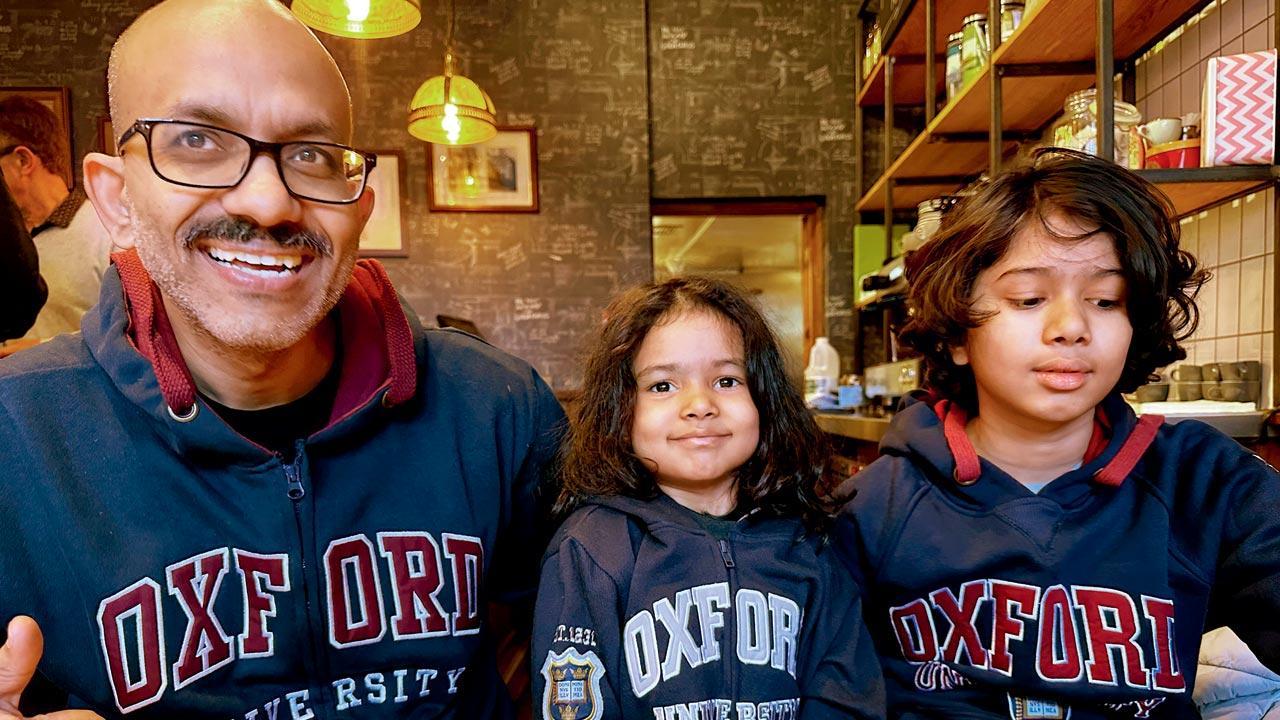Political writer Shantanu Gupta’s latest book places 25 stories from the Ramayana in a modern context, hoping it can make dining table conversation

Gupta with his children Abhiram and Nakshatra, whom he homeschools
What began as looking for answers to his six-year-old son’s question became a curriculum at a university in America, and is now a concise book with a clear goal: To get families to discuss the Ramayana at the dining table.
ADVERTISEMENT
Abhiram’s question to his father, Shantanu Gupta, was this: If they are both avatars of Vishnu, how do Parshuram and Ram meet in the Ramayana?
“At the time,” says the one-time software engineer, “I gave him a basic answer using tech terminology about Rama being one ‘instance’ of the god software and Parshuram being another i.e. a part of the divine essence was contained in both avatars. But I realised I didn’t know the real answer to this question, and it became a good ice-breaker when I approached sadhus at Ayodhya who had dedicated their life to studying the epic [Srimad Valmiki Ramayana] by Valmiki. They are super-smart, logical scholars who are well versed in multiple versions of the epic.”
Like 90 per cent of Indians, Shantanu’s exposure to the text was through producer-director Ramanand Sagar’s television offering that ran weekly in the late 1980s. Then, when he was working on the biography of Uttar Pradesh Chief Minister Yogi Adityanath for six years, he would frequent Lucknow and the politician’s home city of Gorakhpur. “Ayodhya is less than three hours away from both cities,” says Gupta, “so I began going there to know more about the text. I eventually studied the 25,000 shlokas with a book from the Gita Press which has codified the shlokas, offering Hindi translation, plus an explanation of each shloka. It took me five to six years to do this, reading 20-30 shlokas a day.”
He estimates the text weighs about three kilos, too heavy to carry about, and he would take pictures of the pages he intended to read on travel. He found it to be like ChatGPT: “Whatever question you pose to it, be it about plants, war strategy, governance, the Ramayana had the answers. I was looking at it from the lens of a modern parent.”
And so, he began discussing the text with his two children—now 11-year-old son and five-year-old daughter Nakshatra, putting it in day-to-day context. When the pandemic came around, he conducted Ramayana classes for his children’s friends and peers, complete with PPTs, quizzes, and crosswords to bring repetition, revision and reflection. With inquiries flooding from the Indian diaspora that harboured a sense of loss of culture, this model became a start-up The Ramayana School, and Gupta gained traction as an expert in making the ancient text relevant. He even became a faculty member at the Hindu University of America.
Ahead of the inauguration of the Ram Mandir on January 22, 2024 in Ayodhya, all these experiences have culminated into the book, Teachings from the Ramayana on Life and Family (R265, Penguin Random House), released last week. In chronological order, it takes the stories from bal kand (chapters about Ram’s childhood) to yudh kand (chapters pertaining to the war against Ravana), then gives an everyday modern parallel, with a reflection exercise at the end.
“Ramayana has guidelines on how to conduct oneself,” says Gupta, “Look at how King Dashrath and Rama both keep their promises, as leaders, to maintain the sanctity of the given word: King Dashrath could have refused to make Bharat his heir. His promise to Kaikeyi was on the battlefield, with no one as witness but a lowly charioteer. Similarly, when Bharat goes to bring Rama back from the forest, Rama refuses to return to Ayodhya on account of the promise he has made to his father. He cannot even take permission to break his word, given that Bharat does not want to be king, because his father is dead. When Shurpanakha comes to Ram, he refuses her advances saying he is married…this at a time when polygamy was prevalent; remember his father had three wives. We see the many things that Ram stands for—monogamy, rules of warfare and governance are now considered rules of a progressive society worldwide. The modern-day equivalent is of a corporate outfit like the Tatas—grounded in doing what’s right, even at the cost of losing business.”
And when was the last time Ramayana guided him in a mundane situation? “Just the other day, a rickshaw-wala cut across and damaged my car; my impulse was to swear,” says the Noida resident, “But my son was with me and I had to gulp my words. There is a responsibility when you are a leader, which is why my blood boils when actors in Bollywood advertise pan masala. They may have received five, 10 crores for endorsing it and never touch it, but they are heroes to children in villages who will get susceptible cancer because of it. My aim is [to have people do this:] Ramayan katha se uth ke, breakfast table pe jaye.”
 Subscribe today by clicking the link and stay updated with the latest news!" Click here!
Subscribe today by clicking the link and stay updated with the latest news!" Click here!







